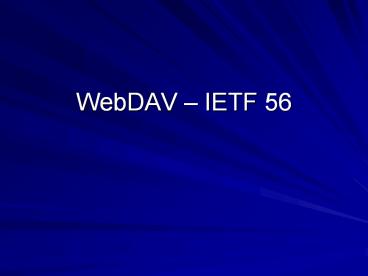WebDAV%20 - PowerPoint PPT Presentation
Title:
WebDAV%20
Description:
Held face-to-face interoperability testing event in Sept, 2002 ... Improved version of Litmus 'Harry' a database-driven compliance tester ... – PowerPoint PPT presentation
Number of Views:27
Avg rating:3.0/5.0
Title: WebDAV%20
1
WebDAV IETF 56
2
Agenda
- Interim WG meeting and Interop Testing - Jim
- RFC2518bis Lisa Dusseault
- GULP Grand Unified Lock Proposal
- Other issues
- Quota Brian Korver
- Bindings Geoff Clemm
- Ordered Collections Geoff Clemm
- ACL Geoff Clemm
- DASL volunteer??
3
Interop/Interim results
- Held face-to-face interoperability testing event
in Sept, 2002 - 37 people attended, tested 13 clients, 16 servers
- much improvement in interoperability
- Progress underway to develop improved compliance
test suite - Improved version of Litmus
- "Harry" a database-driven compliance tester
- Both currently held up by Adobe IP release
process - Work underway to address this
- Continuous online interoperability testing
4
GULP
- Do UNLOCK requests to an indirectly locked
resource work? - Or does the client have to address lockroot?
- Change/clarify what submitted means
- W.r.t. lock tokens submitted in the If header
- Keep in mind goals of RFC2518bis and GULP
- Clarify without changing spec
- Improve interoperability
5
Agreed text so far
- A lock either directly or indirectly locks a
resource. - A LOCK request creates a new lock, and the
resource identified by the request-URL is
directly locked by that lock. The "lock-root" of
the new lock is the request-URL. If at the time
of the request, the request-URL is not mapped to
a resource, a new resource with no content MUST
be created by the request.
6
Agreed text continued
- If a collection is directly locked by a
depthinfinity lock, all members of that
collection (other than the collection itself) are
indirectly locked by that lock. In particular,
if a internal member is added to a collection
that is locked by a depthinfinity lock, and if
the resource is not locked by that lock, then the
resource becomes indirectly locked by that lock.
Conversely, if a resource is indirectly locked
with a depthinfinity lock, and if the result of
removing an internal member URL identifying that
resource is that the resource is no longer a
member of the collection that is directly locked
by that lock, then the resource is no longer
locked by that lock.
7
First problem
- An UNLOCK request deletes the lock with the
specified lock token. The request-URL of the
request MUST identify a resource that is either
directly or indirectly locked by that lock.
After a lock is deleted, no resource is locked by
that lock. - Confirm indirect?
8
Second problem submitted
- A lock token is "submitted" in a request when it
appears in an If header. - Julian asked for this to say that the token must
be tagged with the lockroot URL - That is inconsistent with RFC2518 untagged syntax
- Breaks clients
- Harder to get right
9
What is locked
- The following operations must fail unless the
lock-token for the lock is submitted in the
request - 1. modify the content for a locked resource
- 2. modify a dead property of a locked resource,
- 3. modify a lockable live property be for a
locked resource - 4. modify an internal member URL in a locked
collection, - 5. modify any content, properties or URLs of any
descendent of a depth-infinity locked collection.
10
Last piece
- If a request causes a directly locked resource to
no longer be mapped to the lock-root of that
lock, then the request MUST fail unless the
lock-token for that lock is submitted in the
request. If the request succeeds, then that lock
MUST have been deleted by that request. If a
request would cause a resource to be locked by
two different exclusive locks, the request MUST
fail.
11
Allprop replacement proposal
- ltpropfind xmlnsDAVgt
- ltpropgt
- ltresourcetype/gt
- ltgetlastmodified/gt
- ltquota xmlnshttp//www.xythos.com/ns//gt
- lt/propgt
- ltdead-props/gt
- lt/propfindgt
12
207 Replacement
- Proposal A
- Define partial success response
- New 400-level error code
- Multi-status body
- Proposal B
- Do nothing
- Not an interoperability problem
13
Are ETags required
- Current consensus appears to be
- Servers SHOULD implement
- Standard will explain why this is a really good
idea
14
Response bodies with extensible error codes
- Some text in latest version of rfc2518bis
- To do a complete job, need to define more codes
and exactly what they mean - Guidance from WG?
15
Small changes
- Changed domains to example.com or example.org
- Clarification how live property copy works
differently than live property move - More If header parsing/handling clarity
- Require servers supporting bis to handle commas
in If header































